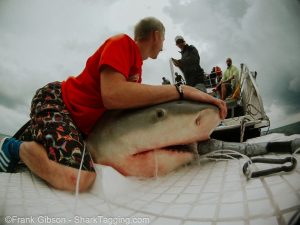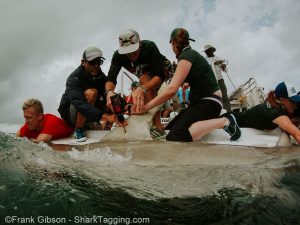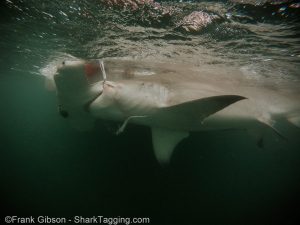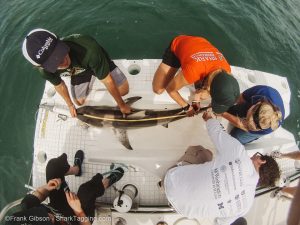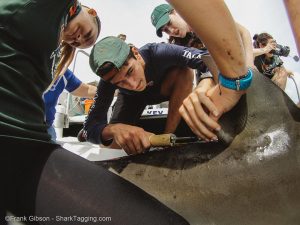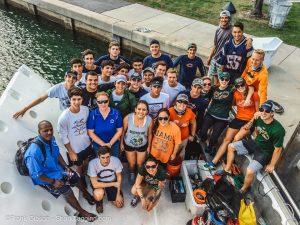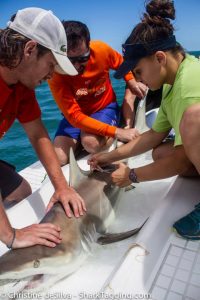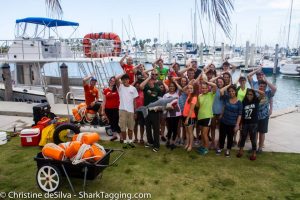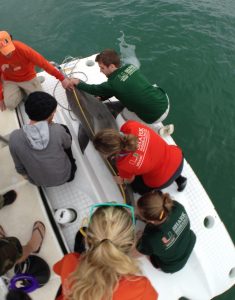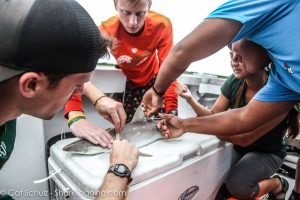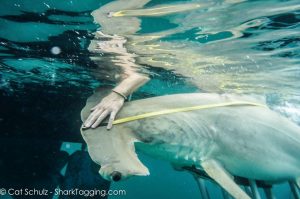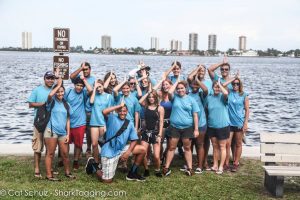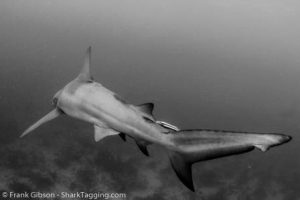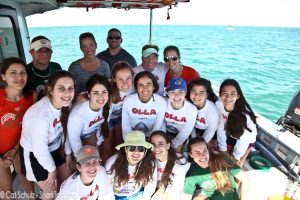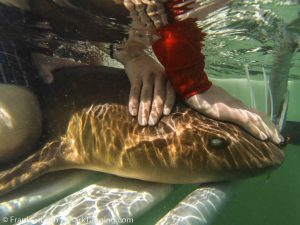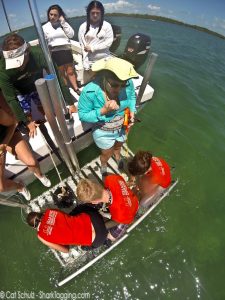By Shannon Moorhead, SRC Intern
As I set out for Crandon Marina early Tuesday morning, my hopes were not high: the sky to the north was a dark, foreboding gray; there was a wall of thunderstorms moving towards Miami on the radar; and I had received multiple worried texts from my parents concerning tornado warnings throughout south Florida. Despite the circumstances, I was eager to get out on the water. Today was our second day on the boat with a film crew, who were shooting a hammerhead shark special for Nat Geo Wild’s “Sharkfest”. Unfortunately, the first day of filming was rather windy, confining us to inshore waters where we caught no sharks. It was the first time I had struck out on a trip and I was afraid the morning storms would keep us in the same location.
Just as the team assembled in the parking lot, the storm hit. My fellow interns and I watched from the safety of Diver’s Paradise dive shop as a torrential rain and whipping winds made the marina look like a scene from a disaster movie about hurricanes. But as we waited out the storm, our luck began to turn. First, I received an email that could turn any day from bad to good: it was my acceptance letter into University of Miami’s Rosenstiel School of Marine and Atmospheric Science! I was so excited (and relieved) that my attitude changed, and with it so did the weather. The skies cleared and revealed a beautiful, calm, sunny day: perfect for going offshore. We loaded the gear onto the boat, the film crew arrived, and we set out to tag some sharks! When we reached our location for the day, the team deployed our first set of 10 drumlines, in addition to a fish trap (to better understand the assemblages of fish species in the areas where we fish for sharks), and took environmental readings (data on seawater temperature, salinity, and dissolved oxygen content). Then the waiting began.
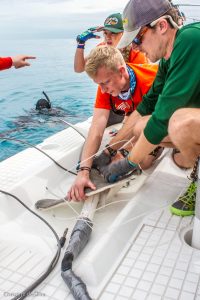
SRC interns Robbie Roemer, Jake Jerome, and Shannon Moorhead secure a female hammerhead shark to the platform
After letting the lines soak for an hour, we moved to pick up the first drum. There was a small twinge of disappointment as the first line came up shark-less, but lack of sharks was not a problem we had for long. On the third line of the day we pulled up exactly what we were looking for: a beautiful great hammerhead shark! A wave of excitement washed over the entire crew; it is fishing after all, and we had been unsure of whether or not we’d be able to catch a hammerhead while we had the film crew with us. We got the shark on board (a 251 cm female, over 8 feet long!) and proceeded to do a quick workup: hammerheads get stressed more easily than other shark species, so we wanted to get her back in the water as soon as possible! Luckily, the SRC team performed like a pit crew for sharks and measured, tagged, drew a blood sample, took a fin clipping, and released her within just a few minutes. As the shark briskly swam off, the team celebrated a job well done and moved on to pick up the rest of the first set.
There was little downtime after the first workup, as we discovered a shark on the very next line! Our program’s director, Dr. Neil Hammerschlag, worked on bringing the shark towards the surface and it became apparent by the way it was fighting that this was a big one. As the shark emerged from the depths we identified it as a massive male lemon shark, indicated by the large second dorsal fin, which is similar in size to the first dorsal. He fought hard, but the team was able to work him up onto the platform to be processed. Measurement revealed he was a whopping 266 cm long, just under 9 feet! Much of the team agreed, it was the largest lemon shark most of us had ever seen. After a quick work up, he was successfully released back into the water and we proceeded to check the rest of our lines.
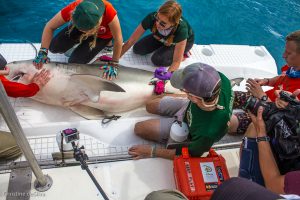
SRC intern Robbie Roemer preps for surgery to implant an acoustic tag in the abdomen of a recently mated female bull shark.
Though line 5 came up empty, set 1 continued to be lucky when we found a bull shark on line 6! At 245 cm, about 8 feet, she was the shortest shark we caught that day, but what she lacked in length, she made up for in girth. As we began to collect data on the female bull, we noticed fresh scars on her pelvic fin: a sign of recent mating! The in-water photographers told us they could see another bull shark circling below the boat; perhaps this was her mate. After the usual workup procedure was completed, an acoustic tag was surgically implanted in the shark’s abdomen. The acoustic tag will “ping” when it comes within a certain distance of receivers placed under the water, allowing for better tracking of the shark’s movements around Miami as part of a study on bull shark utilization of urbanized habitat. The surgical incision was sutured and the girthy female was released in great shape.
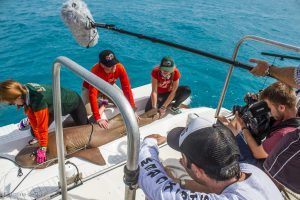
SRC interns Rachel Skubel and Shannon Moorhead secure a female nurse shark while SRC director, Dr. Neil Hammerschlag, discusses the shark for the National Geographic film crew.
Just when we were beginning to think set 1 couldn’t get any luckier, we pulled up a large female nurse shark on the very next line: back-to-back sharks twice in one set! She measured 267 cm, nearing 9 feet long. After a quick workup, the shark was returned to the water for a healthy release. The team pulled up and redeployed the rest of set 1 and went back to check on set 2. Unfortunately, the tide had turned between sets and with it our luck: the next 30 lines came up empty. The team remained in good spirits for the strong first set made up for the lackluster rest of the day. We picked up our fish traps and processed what we found inside (a filefish and cottonwick, a species of grunt) then headed for home, thrilled with the data we had collected (on four different species, nonetheless!) and excited to get back on the boat for our third and final day with National Geographic.

SRC director, Dr. Neil Hammerschlag, thrilled after a great day of tagging!
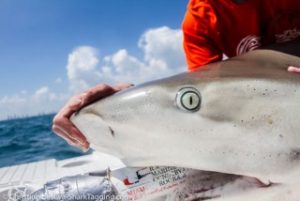
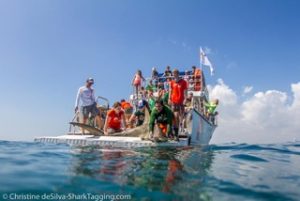

![A Varela High student helps insert a mark-recapture tag into a nurse shark.]](https://sharkresearch.rsmas.miami.edu/wp-content/uploads/2016/03/PIC-1-225x300.jpg)
